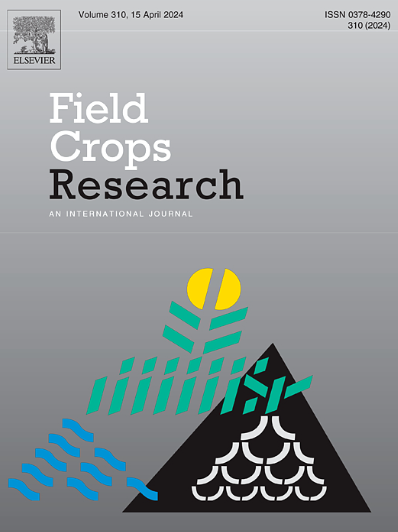Multi-objective optimization of agronomic practices to balance soil fertility, water productivity, and economic returns in saline-alkali farmlands
IF 5.6
1区 农林科学
Q1 AGRONOMY
引用次数: 0
Abstract
Context
Optimizing agronomic management is crucial for improving soil fertility, crop growth, and resource efficiency. However, the interactions between precision irrigation, organic amendments, and straw incorporation in salinized soil remain underexplored.
Objective
This study aimed to evaluate the combined effects of irrigation on crop demand (IOD), organic substitution (OS), and straw return (SR) on soil fertility, crop growth, water productivity (WP), and net profit (NP) in salinized farmland, while identifying the optimal agronomic strategy through multi-objective optimization.
Methods
A 2022–2023 field experiment evaluated eight treatment combinations (CDI (conventional drip irrigation), SNR (straw not return), CK (chemical fertilizer only), IOD, SR, and OS) in saline-alkaline soils of arid regions. Key indicators included soil fertility, sunflower growth, salt leaching efficiency, WP, and NP. Data analysis integrated Pearson correlation, EWM-TOPSIS-AISM optimization, and partial least squares path modeling to assess variable relationships, rank treatment performance, and clarify causal pathways.
Results
IOD+SR+OS significantly enhanced soil fertility, increasing soil mineral nitrogen by 6.87–59.54 %, available phosphorus by 4.96–152.93 %, and exchangeable potassium by 7.02–83.07 % compared to other treatments, which in turn promoted sunflower growth, leading to improvements in plant height (9.92–63.32 %), stem diameter (7.59–47.39 %), leaf area index (19.59–176.50 %), and above-ground dry matter (7.43–68.01 %). Additionally, this integrated approach exhibited the highest salt leaching efficiency (0.0032 g kg⁻¹ mm⁻¹), effectively mitigating soil salinity. Although IOD+SR+CK achieved the highest short-term NP (22.94 and 22.74 (Thousand Chinese yuan) ha⁻1 in 2022 and 2023), IOD+SR+OS demonstrated superior long-term sustainability by optimizing WP (1.42 kg m⁻³, increasing by up to 26.12 %). Multi-objective optimization further confirmed IOD+SR+OS as the most effective strategy for balancing soil fertility, WP, and NP in salinized farmland.
Significance
By highlighting the synergies among IOD, SR, and OS, this study provides empirical evidence for improving soil fertility, optimizing resource efficiency, and enhancing farm profitability in arid regions. These findings contribute to the advancement of precision agriculture strategies that foster sustainable agriculture development.
盐碱地平衡土壤肥力、水分生产力和经济效益的多目标优化农艺实践
优化农艺管理对提高土壤肥力、作物生长和资源效率至关重要。然而,在盐渍化土壤中,精确灌溉、有机改良剂和秸秆掺入之间的相互作用仍未得到充分探讨。目的研究灌溉对盐渍化农田作物需求(IOD)、有机替代(OS)和秸秆还田(SR)对土壤肥力、作物生长、水分生产力(WP)和净利润(NP)的综合影响,并通过多目标优化确定盐渍化农田的最优农艺策略。方法2022-2023年大田试验对干旱区盐碱土8种处理组合(CDI(常规滴灌)、SNR(秸秆不还田)、CK(仅施化肥)、IOD、SR和OS)进行了评价。关键指标包括土壤肥力、向日葵生长、盐淋效率、WP和NP。数据分析整合了Pearson相关性、EWM-TOPSIS-AISM优化和偏最小二乘路径模型,以评估变量关系、对治疗效果进行排名,并阐明因果关系。结果与其他处理相比,od +SR+OS显著提高了土壤肥力,土壤矿质氮提高了6.87 ~ 59.54 %,有效磷提高了4.96 ~ 152.93 %,交换钾提高了7.02 ~ 83.07 %,促进了向日葵的生长,提高了株高(9.92 ~ 63.32 %)、茎粗(7.59 ~ 47.39 %)、叶面积指数(19.59 ~ 176.50 %)和地上干物质(7.43 ~ 68.01 %)。此外,这种综合方法显示出最高的盐浸出效率(0.0032 g kg⁻¹mm),有效地减轻了土壤的盐分。虽然IOD+SR+CK获得了最高的短期NP(2022年和2023年分别为22.94和22.74(千元人民币)ha -毒血症),但IOD+SR+OS通过优化WP(1.42 kg m -毒血症,增加26.12 %)显示了卓越的长期可持续性。多目标优化进一步证实了IOD+SR+OS是盐渍化农田土壤肥力、WP和NP平衡的最有效策略。通过突出IOD、SR和OS之间的协同效应,本研究为改善干旱区土壤肥力、优化资源效率和提高农业盈利能力提供了经验证据。这些发现有助于推进精准农业战略,促进农业可持续发展。
本文章由计算机程序翻译,如有差异,请以英文原文为准。
求助全文
约1分钟内获得全文
求助全文
来源期刊

Field Crops Research
农林科学-农艺学
CiteScore
9.60
自引率
12.10%
发文量
307
审稿时长
46 days
期刊介绍:
Field Crops Research is an international journal publishing scientific articles on:
√ experimental and modelling research at field, farm and landscape levels
on temperate and tropical crops and cropping systems,
with a focus on crop ecology and physiology, agronomy, and plant genetics and breeding.
 求助内容:
求助内容: 应助结果提醒方式:
应助结果提醒方式:


